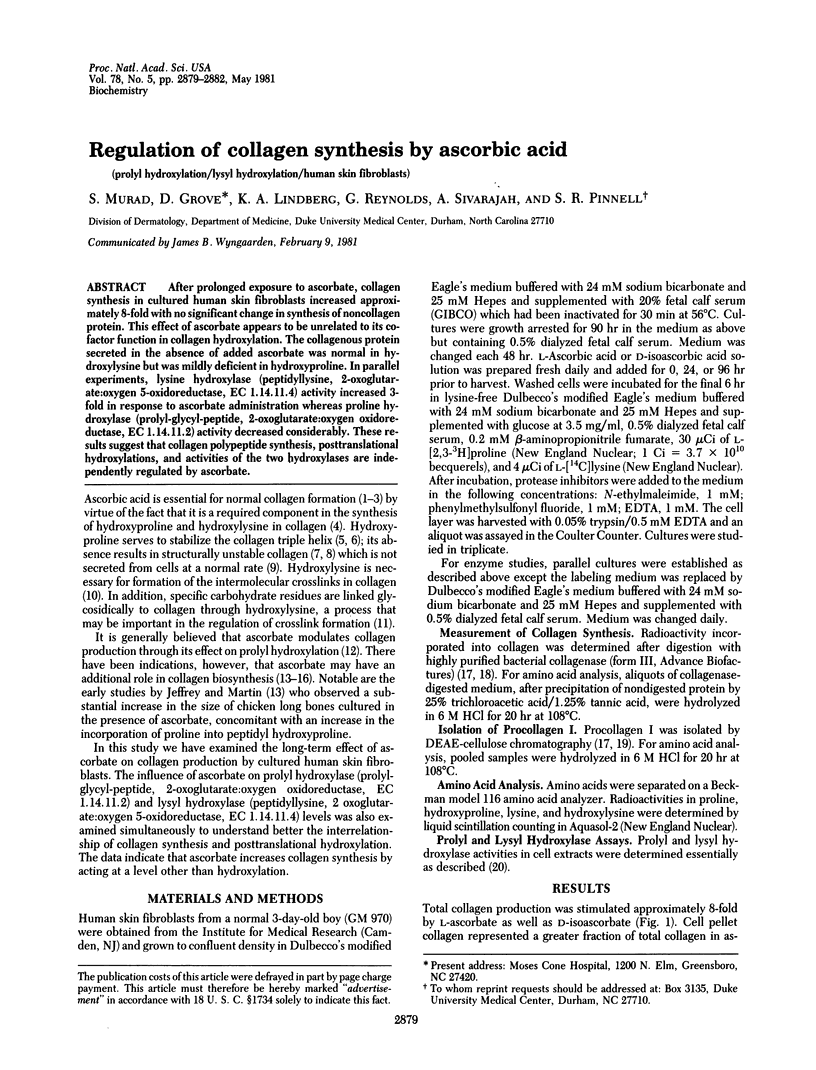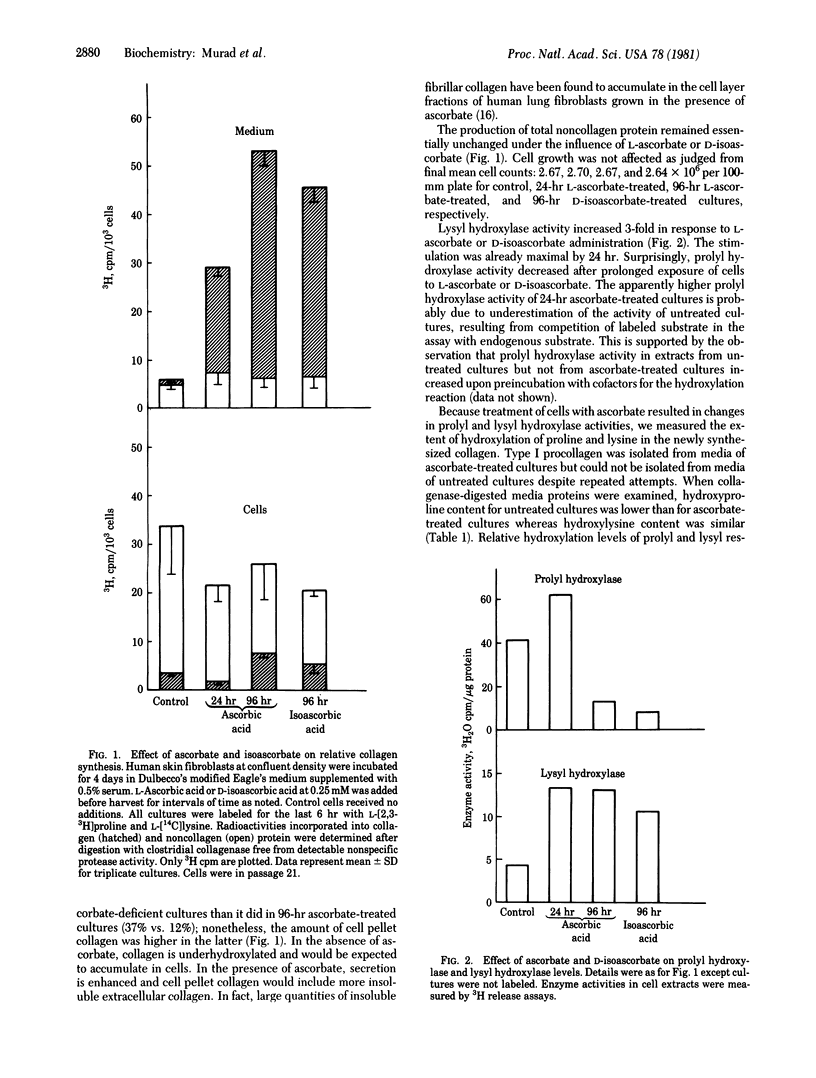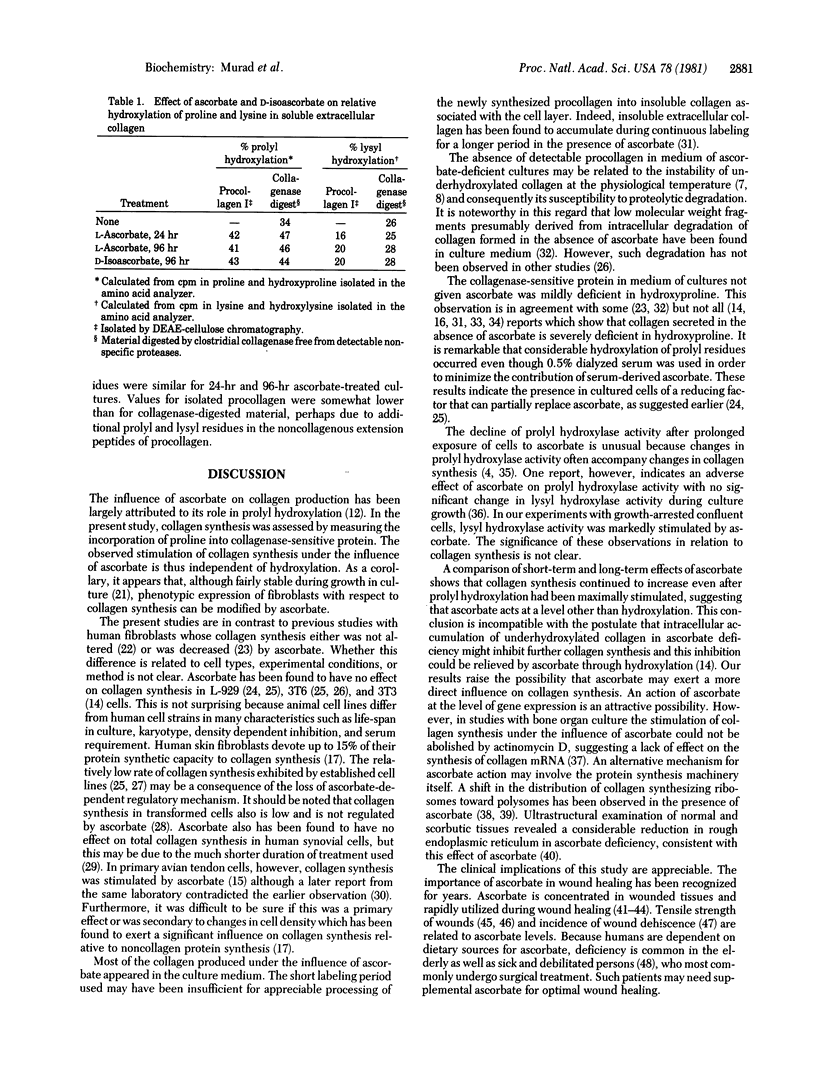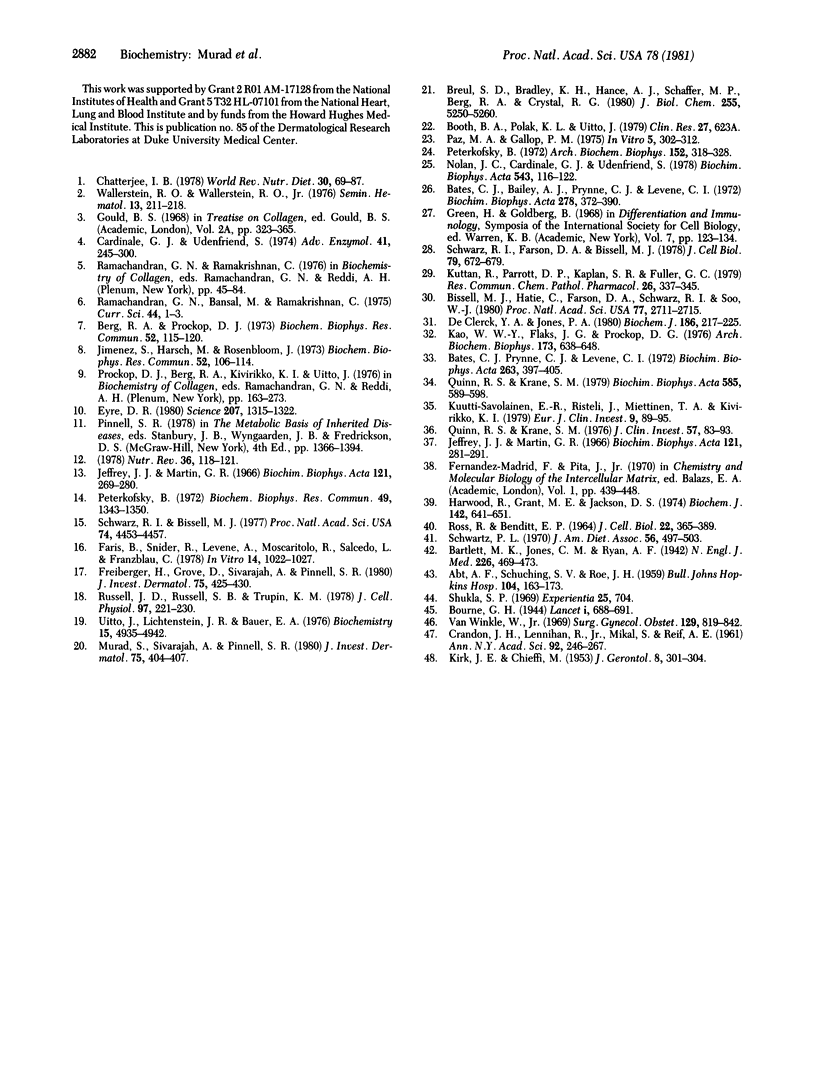Abstract
After prolonged exposure to ascorbate, collagen synthesis in cultured human skin fibroblasts increased approximately 8-fold with no significant change in synthesis of noncollagen protein. This effect of ascorbate appears to be unrelated to its cofactor function in collagen hydroxylation. The collagenous protein secreted in the absence of added ascorbate was normal in hydroxylysine but was mildly deficient in hydroxyproline. In parallel experiments, lysine hydroxylase (peptidyllysine, 2-oxoglutarate:oxygen 5-oxidoreductase, EC 1.14.11.4) activity increased 3-fold in response to ascorbate administration whereas proline hydroxylase (prolyl-glycyl-peptide, 2-oxoglutarate:oxygen oxidoreductase, EC 1.14.11.2) activity decreased considerably. These results suggest that collage polypeptide synthesis, posttranslational hydroxylations, and activities of the two hydroxylases are independently regulated by ascorbate.
Full text
PDF



Selected References
These references are in PubMed. This may not be the complete list of references from this article.
- ABT A. F., VON SCHUCHING S., ROE J. H. Connective tissue studies. I. Relation of dietary and tissue levels of ascorbic acid to the healing of surgically-induced wounds in guinea pigs. Bull Johns Hopkins Hosp. 1959 Apr;104(4):163–173. [PubMed] [Google Scholar]
- Bates C. J., Bailey A. J., Prynne C. J., Levene C. I. The effect of ascorbic acid on the synthesis of collagen precursor secreted by 3T6 mouse fibroblasts in culture. Biochim Biophys Acta. 1972 Sep 29;278(2):372–390. doi: 10.1016/0005-2795(72)90241-3. [DOI] [PubMed] [Google Scholar]
- Bates C. J., Prynne C. J., Levene C. I. The synthesis of underhydroxylated collagen by 3 T6 mouse fibroblasts in culture. Biochim Biophys Acta. 1972 Apr 15;263(2):397–405. doi: 10.1016/0005-2795(72)90091-8. [DOI] [PubMed] [Google Scholar]
- Berg R. A., Prockop D. J. The thermal transition of a non-hydroxylated form of collagen. Evidence for a role for hydroxyproline in stabilizing the triple-helix of collagen. Biochem Biophys Res Commun. 1973 May 1;52(1):115–120. doi: 10.1016/0006-291x(73)90961-3. [DOI] [PubMed] [Google Scholar]
- Bissell M. J., Hatie C., Farson D. A., Schwarz R. I., Soo W. J. Ascorbic acid inhibits replication and infectivity of avian RNA tumor virus. Proc Natl Acad Sci U S A. 1980 May;77(5):2711–2715. doi: 10.1073/pnas.77.5.2711. [DOI] [PMC free article] [PubMed] [Google Scholar]
- Breul S. D., Bradley K. H., Hance A. J., Schafer M. P., Berg R. A., Crystal R. G. Control of collagen production by human diploid lung fibroblasts. J Biol Chem. 1980 Jun 10;255(11):5250–5260. [PubMed] [Google Scholar]
- CRANDON J. H., LENNIHAN R., Jr, MIKAL S., REIF A. E. Ascorbic acid economy in surgical patients. Ann N Y Acad Sci. 1961 Apr 21;92:246–267. doi: 10.1111/j.1749-6632.1961.tb46124.x. [DOI] [PubMed] [Google Scholar]
- Cardinale G. J., Udenfriend S. Prolyl hydroxylase. Adv Enzymol Relat Areas Mol Biol. 1974;41(0):245–300. doi: 10.1002/9780470122860.ch6. [DOI] [PubMed] [Google Scholar]
- Chatterjee I. B. Ascorbic acid metabolism. World Rev Nutr Diet. 1978;30:69–87. doi: 10.1159/000401236. [DOI] [PubMed] [Google Scholar]
- Eyre D. R. Collagen: molecular diversity in the body's protein scaffold. Science. 1980 Mar 21;207(4437):1315–1322. doi: 10.1126/science.7355290. [DOI] [PubMed] [Google Scholar]
- Faris B., Snider R., Levine A., Moscaritolo R., Salcedo L., Franzblau C. Effect of ascorbate on collagen synthesis by lung embryonic fibroblasts. In Vitro. 1978 Dec;14(12):1022–1027. doi: 10.1007/BF02616217. [DOI] [PubMed] [Google Scholar]
- Freiberger H., Grove D., Sivarajah A., Pinnell S. R. Procollagen I synthesis in human skin fibroblasts: effect on culture conditions on biosynthesis. J Invest Dermatol. 1980 Nov;75(5):425–430. doi: 10.1111/1523-1747.ep12524080. [DOI] [PubMed] [Google Scholar]
- Harwood R., Grant M. E., Jackson D. S. Influence of ascorbic acid on ribosomal patterns and collagen biosynthesis in healing wounds of scorbutic guinea pigs. Biochem J. 1974 Sep;142(3):641–651. doi: 10.1042/bj1420641. [DOI] [PMC free article] [PubMed] [Google Scholar]
- Jeffrey J. J., Martin G. R. The role of ascorbic acid in the biosynthesis of collagen. I. Ascorbic acid requirement by embryonic chick tibia in tissue culture. Biochim Biophys Acta. 1966 Jun 29;121(2):269–280. doi: 10.1016/0304-4165(66)90116-4. [DOI] [PubMed] [Google Scholar]
- Jeffrey J. J., Martin G. R. The role of ascorbic acid in the biosynthesis of collagen. II. Site and nature of ascorbic acid participation. Biochim Biophys Acta. 1966 Jun 29;121(2):281–291. doi: 10.1016/0304-4165(66)90117-6. [DOI] [PubMed] [Google Scholar]
- Jimenez S., Harsch M., Rosenbloom J. Hydroxyproline stabilizes the triple helix of chick tendon collagen. Biochem Biophys Res Commun. 1973 May 1;52(1):106–114. doi: 10.1016/0006-291x(73)90960-1. [DOI] [PubMed] [Google Scholar]
- KIRK J. E., CHIEFFI M. Vitamin studies in middle-aged and old individuals. XI. The concentration of total ascorbic acid in whole blood. J Gerontol. 1953 Jul;8(3):301–304. doi: 10.1093/geronj/8.3.301. [DOI] [PubMed] [Google Scholar]
- Kao W. W., Flaks J. G., Prockop D. J. Primary and secondary effects of ascorbate on procollagen synthesis and protein synthesis by primary cultures of tendon fibroblasts. Arch Biochem Biophys. 1976 Apr;173(2):638–648. doi: 10.1016/0003-9861(76)90301-5. [DOI] [PubMed] [Google Scholar]
- Kuttan R., Parrott D. P., Kaplan S. R., Fuller G. C. Effect of ascorbic acid on prolyl hydroxylase activity, collagen hydroxylation and collagen synthesis in human synovial cells in culture. Res Commun Chem Pathol Pharmacol. 1979 Nov;26(2):337–345. [PubMed] [Google Scholar]
- Kuutti-Savolainen E. R., Risteli J., Miettinen T. A., Kivirikko K. I. Collagen biosynthesis enzymes in serum and hepatic tissue in liver disease. I. Prolyl hydroxylase. Eur J Clin Invest. 1979 Feb;9(1):89–95. doi: 10.1111/j.1365-2362.1979.tb01672.x. [DOI] [PubMed] [Google Scholar]
- Murad S., Sivarajah A., Pinnell S. R. Prolyl and lysyl hydroxylase activities of human skin fibroblasts: effect of donor age and ascorbate. J Invest Dermatol. 1980 Nov;75(5):404–407. doi: 10.1111/1523-1747.ep12523660. [DOI] [PubMed] [Google Scholar]
- Nolan J. C., Cardinale G. J., Undenfriend S. The formation of hydroxyproline in collagen by cells grown in the absence of serum. Biochim Biophys Acta. 1978 Sep 21;543(1):116–122. doi: 10.1016/0304-4165(78)90459-2. [DOI] [PubMed] [Google Scholar]
- Paz M. A., Gallop P. M. Collagen synthesized and modified by aging fibroblasts in culture. In Vitro. 1975 Sep-Oct;11(5):302–312. doi: 10.1007/BF02615641. [DOI] [PubMed] [Google Scholar]
- Peterkofsky B. Regulation of collagen secretion by ascorbic acid in 3T3 and chick embryo fibroblasts. Biochem Biophys Res Commun. 1972 Dec 4;49(5):1343–1350. doi: 10.1016/0006-291x(72)90614-6. [DOI] [PubMed] [Google Scholar]
- Peterkofsky B. The effect of ascorbic acid on collagen polypeptide synthesis and proline hydroxylation during the growth of cultured fibroblasts. Arch Biochem Biophys. 1972 Sep;152(1):318–328. doi: 10.1016/0003-9861(72)90221-4. [DOI] [PubMed] [Google Scholar]
- Quinn R. S., Krane S. M. Abnormal properties of collagen lysyl hydroxylase from skin fibroblasts of siblings with hydroxylysine-deficient collagen. J Clin Invest. 1976 Jan;57(1):83–93. doi: 10.1172/JCI108273. [DOI] [PMC free article] [PubMed] [Google Scholar]
- Quinn R. S., Krane S. M. Collagen synthesis by cultured skin fibroblasts from siblings with hydroxylysine-deficient collagen. Biochim Biophys Acta. 1979 Jul 18;585(4):589–598. doi: 10.1016/0304-4165(79)90191-0. [DOI] [PubMed] [Google Scholar]
- ROSS R., BENDITT E. P. WOUND HEALING AND COLLAGEN FORMATION. IV. DISTORTION OF RIBOSOMAL PATTERNS OF FIBROBLASTS IN SCURVY. J Cell Biol. 1964 Aug;22:365–389. doi: 10.1083/jcb.22.2.365. [DOI] [PMC free article] [PubMed] [Google Scholar]
- Russell J. D., Russell S. B., Trupin K. M. Differential effects of hydrocortisone on both growth and collagen metabolism of human fibroblasts from normal and keloid tissue. J Cell Physiol. 1978 Nov;97(2):221–229. doi: 10.1002/jcp.1040970211. [DOI] [PubMed] [Google Scholar]
- Schwartz P. L. Ascorbic acid in wound healing--a review. J Am Diet Assoc. 1970 Jun;56(6):497–503. [PubMed] [Google Scholar]
- Schwarz R. I., Bissell M. J. Dependence of the differentiated state on the cellular environment: modulation of collagen synthesis in tendon cells. Proc Natl Acad Sci U S A. 1977 Oct;74(10):4453–4457. doi: 10.1073/pnas.74.10.4453. [DOI] [PMC free article] [PubMed] [Google Scholar]
- Schwarz R. I., Farson D. A., Soo W. J., Bissell M. J. Primary avian tendon cells in culture. An improved system for understanding malignant transformation. J Cell Biol. 1978 Dec;79(3):672–679. doi: 10.1083/jcb.79.3.672. [DOI] [PMC free article] [PubMed] [Google Scholar]
- Shukla S. P. Plasma and urinary ascorbic acid levels in the postoperative period. Experientia. 1969;25(7):704–704. doi: 10.1007/BF01897573. [DOI] [PubMed] [Google Scholar]
- Uitto J., Lichtenstein J. R., Bauer E. A. Characterization of procollagen synthesized by matrix-free cells isolated from chick embryo tendons. Biochemistry. 1976 Nov 2;15(22):4935–4942. doi: 10.1021/bi00667a029. [DOI] [PubMed] [Google Scholar]
- Van Winkle W., Jr The tensile strength of wounds and factors that influence it. Surg Gynecol Obstet. 1969 Oct;129(4):819–842. [PubMed] [Google Scholar]
- Wallerstein R. O., Wallerstein R. O., Jr Scurvy. Semin Hematol. 1976 Jul;13(3):211–218. [PubMed] [Google Scholar]
- de Clerck Y. A., Jones P. A. The effect of ascorbic acid on the nature and production of collagen and elastin by rat smooth-muscle cells. Biochem J. 1980 Jan 15;186(1):217–225. doi: 10.1042/bj1860217. [DOI] [PMC free article] [PubMed] [Google Scholar]


